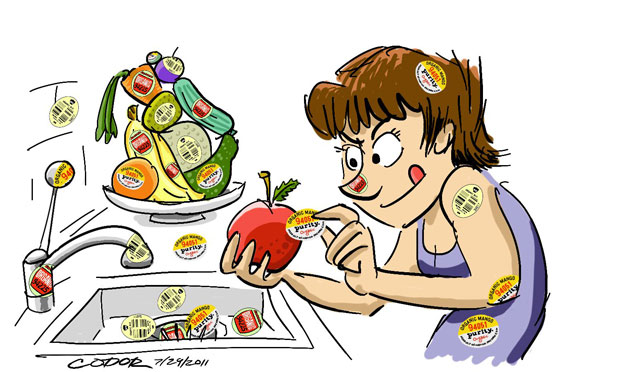There used to be a time when the only sticker found on a piece of fruit was the brand label for Chiquita bananas. My siblings and I used to stick them in the middle of our foreheads when we were kids.
Now, I could cover my entire face with the number of fruit and veggie stickers I've been encountering this summer.
They are ubiquitous. And frustrating. Standing at my counter, getting ready to peel a mango or slice into an avocado, I have to stop, peel the little sticker off the fruit...then off my finger...then find a place to ditch it. I have taken to sticking them into a little notebook I keep in the kitchen to write down my shopping lists.
These little stickers no longer just to trumpet a particular brand. They contain numbers, info about where the produce has come from, and, sometimes, bar codes.
What gives? While I have noticed the stickers more this summer, due to my commitment to eat more fruits and veggies, I didn't give them much thought until prompted by my tennis doubles partner and illustrator, Richard Codor. (That's his work below; he got me exactly right, picking away furiously at mango, peach and avocado labels every day.)
"Amy, you gotta do a piece on those crazy fruit stickers!" he said one morning as we were walking off the courts at the Prospect Park Tennis Center. "Who gets the job of putting them on each and every lemon in the crate?"
Hmmmm.

According to the Produce Marketing Association, which oversees the little buggers, the stickers have been with us since 1990 when the international food supply chain voluntarily decided to create a uniform Price Look Up (PLU) code system that would work in New York City and Nottingham, from Bay Ridge to Beijing. PLUs help growers, producers, packers, and retailers keep track of inventory. It's a four- or five-digit number that identifies the produce, its variety, and its size.
So, the number 4105 is "Apples, Cox Orange Pippin." The funny little British Web site, FruitSticker.com, said 4105 is its "most popular PLU number," with more than 25,000 searches on its site.
Four-digit numbers are for conventionally-grown produce. Organic produce is designated by the addition of a 9 in front of the four-digit commodity/variety/size number. My morning mangoes have the number 94051 ("Mango, Red" in my FruitSticker.com search).
Genetically-modified produce gets an 8 before the four numbers. I got all excited about this, until I thought, "Who the heck would readily put that kind of a sticker on their salmon-gene tomato?"
Meg Miller, spokeswoman for the Produce Marketing Association, confirmed my suspicions.
"Five-digit PLU codes are not mandatory," she said. "The only time a company would use a five-digit code is if they wanted to track a product and do a comparison on sales, like conventional vs. organic."
As for the image of some poor guy with a price gun, applying stickers on each apple coming into the back of a C-Town or Gristede's, Miller put that to rest. She said they are not applied by hand. They're put on by machines, "So no one's touching the product."
She said PLU's were not meant to be used as "consumer communication vehicles." After all, why should you know that "golden kiwis" are labeled 3279, and "regular kiwis" are labeled 4030? For you and me, they are solely to make sure, "You pay the right price for the produce you've chosen," wrote Miller. "The codes also speed up your time in the checkout line because it's faster than having to look them up."
Yeah, but they slow me down on the other end, when I'm trying to consume them.